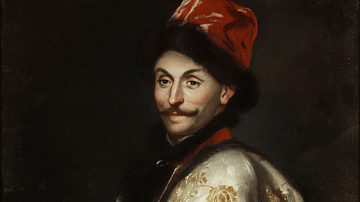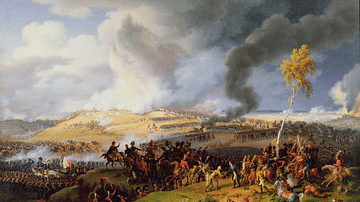
The Great Northern War took place from 1700 to 1721 and was fought between Russia and Sweden during the reign of Peter I of Russia (Peter the Great). One of the key causes of the war was Peter the Great’s desire to have territory on the Baltic Sea and to gain access to the Black Sea.
Many battles were fought over the 21 years, but Russia finally defeated Sweden at the Battle of Poltava in 1709, although a formal peace treaty was not signed until 1721. The renowned French writer Voltaire (1694-1778) called it the “Famous War of the North.”
Background
Since 1697, Peter had been expressing his desire to capture territory on the Baltic Sea so he could build a port there. At that time, the Baltic Sea was under the control of Sweden, which benefitted greatly from the numerous sea trade routes and ports. Russia and Sweden had been in conflict for centuries over the control of land on the coast of Finland. After Ivan IV of Russia’s death (Ivan the Terrible) in 1584, Sweden took control of a large section of Russian coastal land, including Novgorod, which they returned to Russia in 1616. Sweden’s control of these provinces cut off Russia from the sea, and Peter was well aware of the economic loss Russia was suffering as a consequence. Having direct access to the Baltic Sea would mean that Russia would have a direct sea route to Western Europe and countries like England and Holland.
Another possible motivation for the war included the visit to the town of Riga during the Grand Embassy of Peter the Great. After arriving at Riga, the capital of Latvia, the governor denied Peter’s request to view the fortifications. An offended Peter had sworn to one day take control of Riga.
Peter met with Augustus (1670-1733), the Elector of Saxony and King of Poland, in 1698, where Augustus asked Peter and Russia to support him if the Poles turned against him. In return, Augustus promised to help Peter take Riga. Although this verbal agreement was never formalised or written down, it was said that Peter had a deep affinity for Augustus and would have taken it seriously.
Sweden
At the time, Sweden was one of the most powerful nations in Europe, with many lands under its control and access to many rich trade routes. Sweden’s king was Charles XII (l. 1682-1718), who was only 15 years old when he was crowned king in 1697. He inherited a vast Swedish Empire that included Estonia, Scandinavia (except for Norway), Finland, and the Baltic Islands. Sweden also controlled the trade routes along the rivers Neva, Elbe, Oder, and Dvina. The Swedish army could march anywhere in Europe, which made them a key player in war and peace. Despite being so young, Charles had a natural talent for ruling. During his reign, the Swedish Empire reached new heights, although Russia ultimately defeated them in the Great Northern War. However, Charles earned his place in history as an illustrious military hero.
Johann Patkul
Johann Patkul was a Livonian noble and patriot who was an intelligent and cultured man but also single-minded and hot-tempered. Livonia (modern-day Estonia) had become a Swedish territory in 1660. During the reign of Charles XI (r. 1660-1697), the power and influence of the nobility was significantly reduced so that the king could have absolute power. Patkul was strongly opposed to this and pled his case in front of the king, who, although Patkul’s speech moved him, did not change his mind. Patkul wrote an angry petition and sent it to Stockholm, where it was viewed as treason.
Patkul was sentenced to be executed but escaped from the officers who were sent to arrest him. He wandered throughout Europe for six years, dreaming of forming an anti-Swedish partnership with other like-minded leaders. Patkul was especially eager to get Poland on his side, as he knew that Augustus was German and would take the side of the German nobles in Livonia. In 1698, Patkul met with Augustus and convinced him to create an anti-Swedish alliance, promising him that capturing Livonia would be easy and that the nobles in Livonia would recognise him as their rightful king - a prospect that Augustus could not turn down.
Patkul had previously visited King Frederick IV of Denmark (r. 1899-1730), who was eager for Denmark to take part in the war, as they had lost land to Sweden and were weary of the Swedish troops on their borders. Poland and Denmark signed an offensive treaty against Sweden. Patkul suggested that they also convince Russia to join them as he knew that their large number of soldiers would greatly benefit them. However, there was a concern that Russia would not leave the Baltic provinces but claim control of it themselves.

Russia Joins the Fight
Patkul and Augustus’ personal representative, General George von Carlowitz, travelled to Moscow to have an audience with Peter. Once they arrived, they found a Swedish embassy already waiting for Peter. The Swedes sought to uphold all existing treaties between Russia and Sweden, as was the norm whenever a new monarch was crowned.
Peter arrived in Moscow to find these two embassies waiting for him. Over the next few weeks, Peter negotiated with the two parties, although Patkul remained incognito. The Swedish embassy was aware of Augustus’ embassy but just assumed that they, too, were signing peace treaties with Russia. To appease them, Peter treated them with the highest honours and signed everything they put before him. Peter concluded their meetings by writing a personal letter to Charles XII. Little did the Swedes know that just a few days later, Peter would sign a treaty with Augustus to go to war against Sweden no later than April 1700.
Preparing for War
Peter made it clear that the war against Sweden would not begin until Russia had signed a peace treaty with the Ottoman Empire. However, he knew that he would need all the time possible to prepare his soldiers to face a Western army. He put out a decree that called for freedmen to fight for Russia, offering to pay them eleven rubles a year with a drink allowance. He also called for landowners to give one serf for every 50 serf households in their possession and for monasteries to give one recruit for every 25 households they oversaw. Within a few months, he had reshaped the army into a force of over 30,000 men consisting of 35 regiments. Most of the colonels in command were foreigners. Peter outfitted the army in dark green coats, breeches, boots and hats and equipped them with bayonets and muskets. They were also taught to march in columns and stand in line.
While Peter was waiting for the peace treaty with the Ottoman Empire to be finalised, his new allies decided to go ahead and attack Sweden with Augustus’ troops invading Livonia and Riga. Carlowitz was killed during this invasion. Meanwhile, Fredrick IV and the Danish troops laid siege to the town of Tonning. Peter was annoyed with both of his allies for attacking without him.
Relations with Turkey became so bad that Peter decided to reestablish his friendly relations with Sweden in the meantime and sent a Russian embassy to Stockholm to convince Sweden that they wanted peace. Peter even promised to take Riga off Augustus if he managed to capture it. Sweden was appeased by this embassy and parted with Russia on good terms. Months passed, and finally, in August of 1700, Russia’s peace treaty with the Ottoman Empire was complete, and Russia formally declared war on Sweden.
Siege of Narva
The city of Narva was located on the bank of the river Naróva. Built by the Danish in the 13th century, it was surrounded by a well-armed fortress. Peter’s allies had tried to dissuade him from attacking Narva as they did not want him taking control of it. However, Peter knew that if he gained Narva, he would gain more access to the sea and would be able to build more ships.
The Russian army arrived in Narva in September and soon set about laying siege to the town with the help of Russian field marshal Duke Charles Eugène de Croy (1651-1702) and an engineer named Hummert, who had been sent by Augustus. It was soon apparent that the Russian forces were not up to the task of a siege. There were not enough men, and the Russian cannons were not causing enough damage. Peter also learnt that Augustus had retreated from Riga. The final blow came when the engineer decided to side with Sweden.
As Winter approached, the Russian army was faced with sickness and, surprisingly, with Peter’s desertion. There are various reasons for Peter’s retreat. Perhaps he thought that he could be more useful by organising supplies for the Russian army and that the siege would still be in place when he returned. Nonetheless, Peter left the command to Duke de Croy and left.
Charles XII saw this as the perfect opportunity to push his men towards Narva. Impressively, 8,000 of Charles XII’s men took on the Russian army, which was around three times larger and managed to defeat them on November 20, 1700. The Russian army hated most of their officers, and with Peter gone, they were like sheep without a shepherd. Over 5,000 of them were lost. The Swedish army also had a snowstorm on their side, as the snow was flying in the Russian army’s faces, seriously hindering their view.
Peter learnt of this defeat a short distance from Narva and ordered the surviving troops to go to Nóvgorod. Europe praised the bravery of Charles XII while Peter was mocked. Almost a decade would go by before the Russian’s defeat at Narva would be avenged.

Aftermath
Peter did not let Russia’s defeat distract him from his primary goal. If anything, he became more passionate and committed to the war. His main fear after the failed siege at Narva was Charles XII marching on Moscow, which luckily did not occur. He then had to rebuild his army. The scattered troops were reorganised and numbered over 34,000; fortifications were strengthened, new weapons were gathered, with church bells being melted for guns and cannons, and new taxes were introduced to pay for it all.
In 1701, Peter met with Augustus for negotiations, which lasted for ten days. Both Peter and Augustus agreed to continue the war. They decided they would need each other’s consent before withdrawing from the war. Poland would focus on Livonia and Estonia, while Russia would work on Karelia and Ingria. Peter appointed the nobleman Boris Sheremetev (1652-1719) as the new Commander-in-Chief of the Russian army.
Multiple Campaigns
Charles XII decided that he could not fight both Russia and Poland at the same time and turned his attention towards defeating Augustus. During that time, Russia enjoyed a few victories. The first one was the defeat of the Swedish navy at Archangel (located near the White Sea).
In January 1702, Russia won their first great victory at Erestfer in eastern Livonia, with around 3,000 Swedish soldiers being killed. Moscow celebrated this victory with a huge banquet and fireworks. In July 1702, Sheremetev and his men faced the Swedish Colonel Wolmar Anton von Schlippenbach (1653-1721) at Hummelshof in Livonia, where the Swedish troops were almost wiped out. Livonia was now virtually undefended, and it did not take much for Sheremetev and his men to capture all the remaining towns.
Before too long, Peter thought about attacking from the sea and set to work building small boats that could outnumber and overwhelm the larger Swedish ships. He built these ships on Lake Ladoga, which was already home to Swedish galleys and brigantines. On June 20, 1702, 400 Russian soldiers advanced on the Swedish, causing them to retreat. Another attack was carried out on September 7, and the Swedish vacated Lake Ladoga. A similar attack was taking place on Lake Peipus, which caused the Swedes to retreat hastily. Narva was in Russian hands later that year.

Capturing Nöteborg Fortress
Nöteborg Fortress was built by the residents of Novgorod during the 13th century and was taken by the Swedes in 1611. It controlled multiple trade routes in the Baltic and throughout Lake Ladoga and Russia. Thus, it was high on Peter’s agenda to win it back. The Russian army advanced on the fortress and bombarded it with mortars for ten days until the soldiers inside surrendered. Nöteborg Fortress was the first significant fortress to be taken by Russia, and Peter was overjoyed. This victory was celebrated by a grand entrance into Moscow and triumphal arches. The Russians renamed the fortress Schlusselburg.
Establishing a Russian Coastline
In 1703, Peter decided it was time to establish a Russian coastline across the Baltic. 20,000 soldiers marched towards the sea, with Peter following in an entourage of 60 boats. They reached a small Swedish settlement, which was quickly captured by the following day. The Russian camp heard whispers that a Swedish fleet was on its way. Once the Swedish fleet had arrived, the Russians tricked them by replying to their signal guns and hid in the marshes of the Neva, waiting to ambush their ships.
This victory was a monumental one for Peter, as it gained him access to the Baltic Sea and territory along the length of the Neva River, which was his main objective of the war. The region of Ingria was also returned to Russia. This strategic win allowed Peter to build the great city of St. Petersburg, which the Swedish attempted to attack multiple times over the years but always failed in their attempt to bring the city down.
The Capture of Dorpat & Narva
In 1704, Peter instructed Sheremetev to capture the fortress town of Dorpat (in modern-day Estonia). Dorpat was destroyed in the 16th century by Ivan the Terrible but it had been rebuilt since then. Hence, the Russians faced a great challenge. Peter arrived in Dorpat on July 3 and reorganised his men. Ten days later, Dorpat had fallen. Now, Russia’s attention was turned to Narva once again, where preparations for an attack were already underway.

On July 30, Narva was bombarded for ten days. On August 9, the Russians stormed into Narva. Still riled up for battle, they began slaughtering men, women and children. Peter called for a ceasefire and killed Russian soldiers who disobeyed his orders. This victory was especially sweet for Peter, as he was still frustrated by Russia’s defeat at Narva four years earlier.
Battle of Poltava
The Battle of Poltava (modern-day Ukraine) in 1709 was a decisive battle in the Great Northern War. Charles XII was confident in his ability to defeat Russia, and Peter was ready to win this war.
Charles XII had decided that he wanted to take the town of Poltava, a small town on the bank of the Vorskla River. He had heard rumours that 5,000 Russian soldiers were staying there and had an abundance of supplies - something that his men were in great need of. In May of 1709, Charles XII began a siege that his generals adamantly opposed, as the Swedish army was no longer the strong, large army it once was.
Meanwhile, the Russians had taken position across from Poltava and were waiting for Peter’s arrival. Unlike other times, Peter took full command of this battle. After learning that the Swedes were running out of gunpowder, he decided it was time to cross the Vorskla River. On June 27, the Swedes attacked, but it did not take long for Russia’s superior army to thwart their attack.
The two armies then met in an open field and battled each other. Peter was in the thick of battle and showed great courage, inspiring his men. Although Charles XII was seriously injured, he had himself carried out on a stretcher as he encouraged his men. Within a few hours, the battle was over, with the Russians victorious. The remainder of the Swedish army had been arrested, marking the end of the once brave and mighty army.
The Treaty of Nystadt
From 1718-1721, attempts at peace between Russia and Sweden were made, with complications arising at the end of 1718 with Charles XII’s death. 1719 included Russian attacks on the Swedish coast, the new Swedish queen, Ulrika Eleonora (1688-1741), turning down Russia’s terms, and George I of Great Britain’s (r. 1714-1727) Anti-Russian Policy, which sought to force Russia to return its conquered lands to Sweden.
After much back and forth between Russia and Sweden and with other countries like Britain and Prussia getting involved, the Treaty of Nystadt was finally signed on August 30, 1721. Russia gave up Finland, agreed to pay a large amount of money for Livonia, gave the Swedes the right to buy duty-free grain in specific regions, and released all Swedish hostages. In return, Sweden gave Estonia, Livonia, Ingria and the Vyborg District to Russia.
Aftermath of the Great Northern War
On October 22, 1721, the Holy Synod and the Senate requested that Peter take the title of Russian Emperor and ‘Peter the Great.’ After some hesitation and lots of thought, Peter finally accepted these titles. In celebration of his great victory, Peter pardoned all prisoners (except for murderers). There were also multiple parties, banquets and masquerade balls, with grand celebrations scheduled to take place in October 1721 and January 1722. The end of the Great Northern War ushered in a new golden age for Russia and proved that Peter was worthy of being Peter ‘the Great.’










